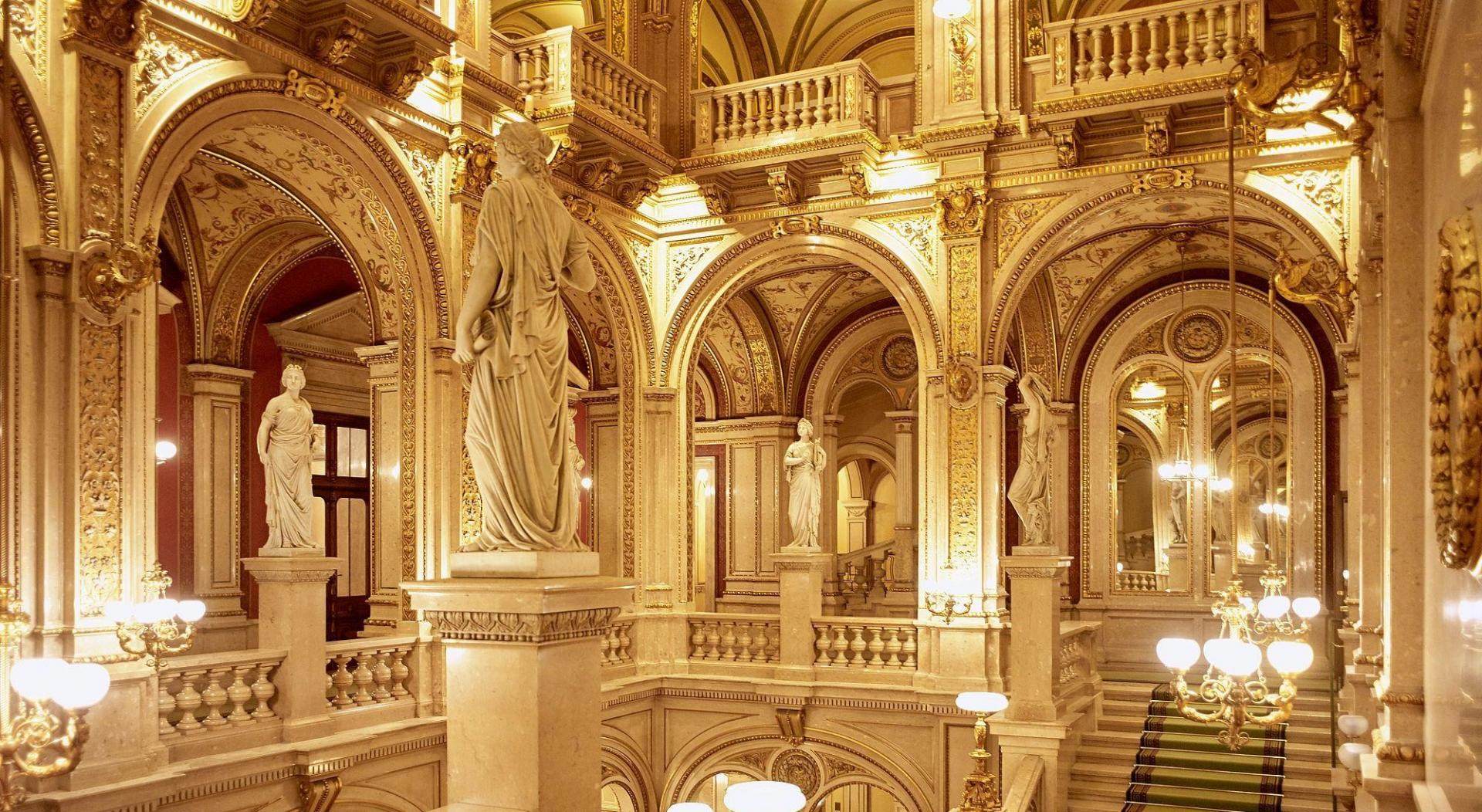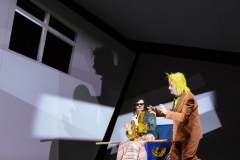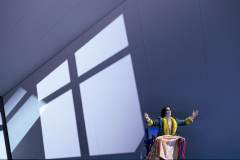Fin de Partie
Mo | Tu | We | Th | Fr | Sa | Su |
Fin de partie - György Kurtág | Opera
Opera in one act, text by the composer after the play of the same name by SAMUEL BECKETT
Total Duration: 105 minutes
Synopsis
1. Prologue: Roundelay
Nell sings a poem about steps on the beach at the end of the day.
2. Pantomime of the Clov
Hamm in his Rollfauteuil is covered with a sheet. Also two garbage cans standing in an empty room. Clov surveys the room. He fetches a ladder so that he can see out of the windows. He also looks under Hamm's sheet and laughs. Finally, he pulls the sheet off Hamm's armchair. Hamm's face is covered with a handkerchief.
3. Clov's first monologue
Clov ponders the end. He brings a parable into play: if you always put one grain on top of another, one day a heap is formed - "the impossible heap". He wants to go into his kitchen with its "pretty dimensions" - three meters by three meters by three meters - and wait there until Hamm whistles.
4. Hamm's first monologue
Hamm wakes up yawning: now it's his turn to play. Hamm ponders the extent of his suffering in relation to other suffering. Hamm expresses the need for an end "even in this shelter" and deals with his own reluctance to end. Finally, he decides he would rather go to sleep and blows his whistle. Clov, who comes in on the whistle, refuses to let him go to sleep: He had just let him up and had things to do.
5. Garbage can
The lid of one of the garbage cans opens and Nagg emerges. He knocks on the lid of the other one and Nell looks out. At Nagg's request, the two try unsuccessfully to kiss. This daily "comedy" goes against Nell's grain. Nagg has lost a tooth. The two check their senses: her eyesight has suffered, but her hearing has not. Nagg remembers the tandem accident in the Ardennes in which they both lost their legs. They have a great time.
Hamm complains about the noise they make, which prevents him from sleeping. He also complains about a drop in his head, "like a heart", as he says. This amuses Nagg, who is reprimanded by Nell: There is nothing funnier than misfortune, he says, but a joke that is told too often is no longer laughable. Nagg tells the joke about the tailor, the trousers and the creation of the world. While he is having a great time with the punchline, Nell is caught up in a memory of Lake Como, where they got engaged.
On Hamm's rebuke, Nagg disappears into his bucket. Hamm calls Clov to "throw them both into the sea". Clov takes Nell's arm and realizes that she no longer has a pulse.
6. Roman
Now Hamm wants to tell his story. He promises Nagg a dragee so that he will listen to him. The story is about a man who appeared crawling on his stomach on Christmas night to ask for food for his child or to ask Hamm to take him in. Hamm is dissatisfied with his own narrative. The story would require the introduction of more characters. He whistles for Clov, who explains that he has come across a rat in the kitchen. Its extermination was interrupted by Hamm's whistling. Hamm calls for prayer, but he, Nagg and Clov fail to pray. The existence of God is called into question. When Nagg demands his reward for listening, Hamm tells him that there are no more dragees.
7. Nagg's monologue.
Nagg compares the current situation with the time when Hamm was a child and called for him at night. He hopes that at some point a situation will arise again in which he is Hamm's only hope.
8. Hamm's penultimate monologue
Hamm expresses his sadness. He thinks of all those who have crawled out of every corner and whom he could have helped and saved. But then he reminds them that they are on earth and that there is no remedy. He weighs up his options and reflects on the end, which is already in the beginning. He varies the parable of the grains and the heap: The whole of life is spent waiting for it to become a life. He whistles for Clov.
9. Dialogue between Hamm and Clov
Hamm and Clov talk about their mutual dependence. The rat in the kitchen has escaped, says Clov. Hamm repeatedly asks Clov if it's not time for his tranquilizer, and Clov finally answers in the affirmative. But there is no more tranquillizer and there never will be.
10. "It's over, Clov" and Clov's vaudeville
It's over, Hamm explains: he no longer needs Clov. Clov should just leave him the boat hook. Before Clov leaves him, he asks him for a few words "from his heart". Clov sings him a vaudeville song.
11. Clov's last monologue
Clov muses on the order of things and the relationship between suffering and punishment, availability and freedom. Not being able to change his habits means that "it" will never end and he will never leave. He imagines an end that happens by itself. When he falls, he will weep with happiness.
12. Transition to the finale
Clov and Hamm formally thank each other. Hamm asks Clov to cover him with the cloth before he leaves, but Clov has already left.
13. Hamm's last monologue
While Hamm is trying to move away with the help of the boat hook, Clov comes back in dressed as a traveler. Hamm doesn't notice him.
Hamm wants to devote himself to the endgame that he has always lost, he doesn't want to lose any more. He returns to his story once again: he reminded the man who wanted to keep his little son with him of what the earth is now. And reminded him of his responsibility.
End of the novel
Hamm whistles once more, calling for his father. then he throws his whistle away and unfolds his handkerchief.
Program and cast
Nagg: Charles Workman
Nell: Hilary Summers
Hamm: Philippe Sly
Clov: Georg Nigl
Musical direction: Simone Young
Staging, stage & costumes: Herbert Fritsch
Light: Friedrich Rom
Vienna State Opera
Public Transport
Subway lines: U1, U2, U4
Trams: 1, 2, D, J, 62, 65
Buses: 59A
Local Railway: Badner Bahn
Stops: Karlsplatz / Opera
Taxi stands are available nearby.
Parking
Parking is only € 6, - for eight hours!
The Wiener Staatsoper and the ÖPARK Kärntner Ring Garage on Mahlerstraße 8, under the “Ringstraßengalerien”, offer the patrons of the Vienna State Opera a new, reduced parking fee. You can park in the Kärntner Ring Garage for up to 8 hours and pay only a flat fee of € 6, -. Just validate your ticket at one of the discount machines inside the Wiener Staatsoper. The normal rate will be charged for parking time greater than 8 hours. The validation machines can be found at the following coat checks: Operngasse, Herbert von Karajan-Platz, and the right and left and balcony galleries.
Important: In order to get the discount, please draw a ticket and do not use your credit card when entering the garage!
After devaluing your ticket in the Wiener Staatsoper you can pay comfortably by credit card or cash at the vending machines.
The machines accept coins and bills up to 50.- Euro. Parking time longer than 8 hours will be charged at the normal rate.
History
The structure of the opera house was planned by the Viennese architect August Sicard von Sicardsburg, while the inside was designed by interior decorator Eduard van der Nüll. It was also impacted by other major artists such as Moritz von Schwind, who painted the frescoes in the foyer, and the famous "Zauberflöten" (“Magic Flute”) series of frescoes on the veranda. Neither of the architects survived to see the opening of ‘their’ opera house: the sensitive van der Nüll committed suicide, and his friend Sicardsburg died of a stroke soon afterwards.
On May 25, 1869, the opera house solemnly opened with Mozart's Don Giovanni in the presence of Emperor Franz Joseph and Empress Elisabeth.
The popularity of the building grew under the artistic influence of the first directors: Franz von Dingelstedt, Johann Herbeck, Franz Jauner, and Wilhelm Jahn. The Vienna opera experienced its first high point under the direction of Gustav Mahler. He completely transformed the outdated performance system, increased the precision and timing of the performances, and also utilized the experience of other noteworthy artists, such as Alfred Roller, for the formation of new stage aesthetics.
The years 1938 to 1945 were a dark chapter in the history of the opera house. Under the Nazis, many members of the house were driven out, pursued, and killed, and many works were not allowed to be played.
On March 12, 1945, the opera house was devastated during a bombing, but on May 1, 1945, the “State Opera in the Volksoper” opened with a performance of Mozart's THE MARRIAGE OF FIGARO. On October 6, 1945, the hastily restored “Theaters an der Wien” reopened with Beethoven's FIDELIO. For the next ten years the Vienna State Opera operated in two venues while the true headquarters was being rebuilt at a great expense.
The Secretary of State for Public Works, Julius Raab, announced on May 24, 1945, that reconstruction of the Vienna State Opera would begin immediately. Only the main facade, the grand staircase, and the Schwind Foyer had been spared from the bombs. On November 5, 1955, the Vienna State Opera reopened with a new auditorium and modernized technology. Under the direction of Karl Böhm, Beethoven’s FIDELIO was brilliantly performed, and the opening ceremonies were broadcast by Austrian television. The whole world understood that life was beginning again for this country that had just regained its independence.
Today, the Vienna State Opera is considered one of the most important opera houses in the world; in particular, it is the house with the largest repertoire. It has been under the direction of Dominique Meyer since September 1, 2010.

 EN
EN DE
DE IT
IT FR
FR ES
ES RU
RU JP
JP RO
RO
 Seating plan
Seating plan 

